
This is a list of sites in Minnesota which are included in the National Register of Historic Places. There are more than 1,700 properties and historic districts listed on the NRHP; each of Minnesota's 87 counties has at least 2 listings. Twenty-two sites are also National Historic Landmarks.
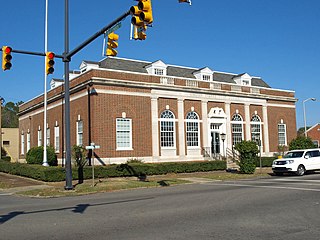
The Post Office Historic District is a historic district in Greenville, Alabama at 100–115 West Commerce and 101 East Commerce Streets. It was listed on the National Register of Historic Places in 1986 and includes Early Commercial architecture, Classical Revival architecture, and Art Deco architecture in its nine contributing buildings.

Butler Chapel A.M.E. Zion Church is a historic African Methodist Episcopal Zion Church built in 1913, and located in Greenville, Alabama. It was one of three significant meeting places for African-Americans living in Greenville during the early-20th century.
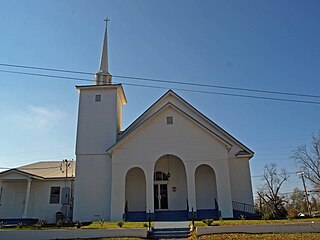
First Baptist Church is a historic Baptist church at 707 South Street in Greenville, Alabama. It was founded and built in 1870 by Rev. Stuart Adams and added to the National Register of Historic Places in 1986.
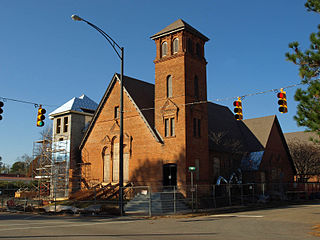
First Presbyterian Church is a historic Presbyterian church at 215 East Commerce Street in Greenville, Alabama. It was built in 1886 and added to the National Register of Historic Places in 1986. The church is a member of the Presbyterian Church in America.

The Theological Building at A.M.E. Zion Theological Institute was a historic African Methodist Episcopal Zion Church school building on East Conecuh Street in Greenville, Alabama. This later became part of Lomax-Hannon Junior College. The building was built in 1911 and added to the National Register of Historic Places in 1986. The Theological Building was demolished in 2014.

The Buell–Stallings–Stewart House is a historic residence in Greenville, Alabama. The house was built in 1874 by a local lawyer David Buell, who later sold it to U. S. Congressman Jesse F. Stallings. Stallings sold the house to A. Graham Stewart, a local merchant, in 1901. The house is built in a Carpenter Gothic style, rare in Alabama, and features a steeply sloped roof and several sharply pointed gables and dormers. A flat-roofed, octagonal porch projects over the front entry. Each window and door is topped with a decorative Gothic arch molding with a diamond in the middle. The house was listed on the National Register of Historic Places in 1986.

Greenville City Hall in Greenville, Alabama is a historic city hall. The building was designed by Montgomery architect Moreland Griffith Smith, and built in 1936–37 by workers from the Works Progress Administration. The building is designed in a Colonial Revival style with Palladian influences, a popular style in the 1930s due to the recent restoration of Colonial Williamsburg. It was built on the site of a grammar school that was originally built in the 1890s, but burned in the early 1920s and again in 1927. The building is constructed of brick, with a full-height portico around the main entry. Each window on the first floor is topped with an ashlar keystone. The corners of the main block are adorned with stone quoins. The building was listed on the National Register of Historic Places in 1986.
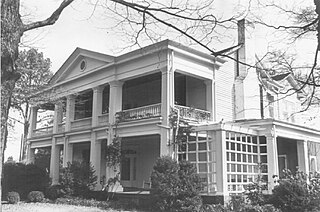
Woodside was a historic residence in Belle Mina, Alabama. The land on which the house was built was originally part of Alabama Governor Thomas Bibb's estate, Belle Mina. Thomas' son, Porter Bibb, built Woodside in 1861 for his daughter, Mary Chambers Bibb. The two houses stood one-half mile (1 km) apart. Woodside was a two-story Greek Revival house, originally with a central, double-height portico that was extended to the full width of the façade in the early 1900s. The house has a center-hall plan, with two rooms on either side of a hallway on both floors. The rear of the house was originally a pair of one-story wings, but a second story was added in an early 20th-century renovation. Greek Revival details continued inside the house, such as mantels and architrave-framed panels in the stairwell. The house was listed on the National Register of Historic Places in 1982. Woodside was destroyed by a fire in late November 2022.
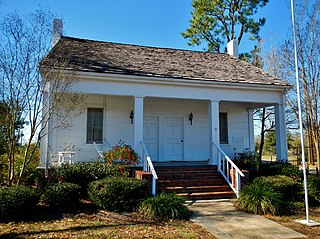
The Kennedy House is a historic residence in Abbeville, Alabama. The house was listed on the Alabama Register of Landmarks and Heritage in 1976 and the National Register of Historic Places in 1978.

The W. S. Blackwell House is a historic residence located at 211 Ft. Dale Street in Greenville, Alabama. The house was built around 1930, on land previously occupied by W. S. Blackwell's father-in-law's house, which burned in the 1920s.

The Commerce Street Residential Historic District is a historic district in Greenville, Alabama. The district consists of four houses along Commerce Street, constructed between 1846 and 1895. They represent the final and last remaining residential construction on the town's main street.

Confederate Park is a park in Greenville, Alabama. The park was established in 1902 in front of the First Methodist Church on 1 acre of land donated by the church to the United Daughters of the Confederacy. The following year, the UDC commissioned a 16-foot (4.8-m) marble statue of a Confederate soldier on a pedestal. In the following years, many shrubs and shade trees were planted, and in 1909 a fountain was donated by Mayor Claude E. Hamilton, and was placed in the center of the park. Sidewalks along Commerce Street and diagonal walkways through the park, as well as several benches, were also placed. In the 1920s, a landscape architect was hired to place flowers and evergreens. In 1937, the city hall was built across Commerce Street from the park.
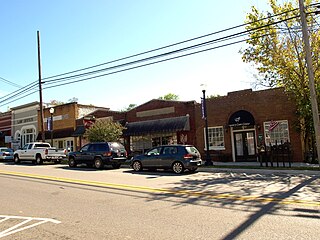
The Springville Historic District is a historic district in Springville, Alabama. The area around the "Big Spring" remained sparsely populated from 1814, when the land was ceded to the United States by the Creek Nation, until after the Civil War. A post office was established in 1834, and a sawmill was founded in 1861, but development did not begin in earnest until the coming of the Alabama and Chattanooga Railroad in 1870. Now connected to Atlanta and Columbus, Mississippi, business and industry began to center in Springville, and the town was a center for moving ore from the surrounding hills to industrial centers in Birmingham and Tuscaloosa.

The East Commerce Street Historic District is a historic district in Greenville, Alabama. The district contains Greenville's oldest commercial buildings, as well as the Butler County Courthouse. The first courthouse on the site was built in 1822; the current, fourth, courthouse was completed in 1903. The commercial buildings date from the 1880s through 1928 and are primarily vernacular brick structures. A fire in 1927 destroyed many buildings along Commerce Street. A National Guard Armory was built south of the courthouse, on Conecuh Street, by the Works Progress Administration in 1936.
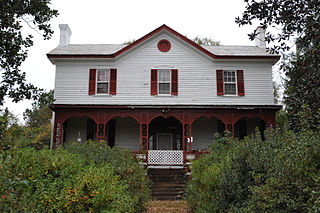
The Evens-McMullan House is a historic residence in Greenville, Alabama. It was built in the late 1860s by Holden Evens, a lumberman who specially selected the timber used in its construction. It was purchased in 1891 by Frank McMullen, a Greenville jeweler.
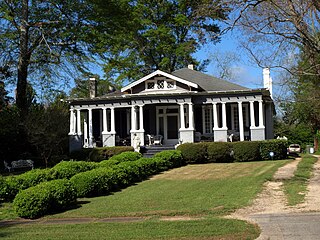
The Fort Dale-College Street Historic District is a historic district in Greenville, Alabama. The district contains Greenville's oldest existing affluent residences, dating to as early as the 1850s. In the initial federal land sale following the Creek War, the area that became northwest Greenville was claimed by William Dunklin. Dunklin sold the claim to William Burnette, who began to parcel the land for sale and to give to family members. Burnette's daughter and son-in-law built a Corinthian-columned Greek Revival home in 1857. A few other pre-Civil War houses remain, and construction continued after the war, including a school building that was later converted into a house. Most of the early residences were large, and built in Greek Revival, Second Empire, and Colonial Revival styles. Beginning in the 20th century, bungalows and cottages on smaller lots began to emerge. One of the later constructions in the district is a Spanish Colonial Revival house, built in 1928.
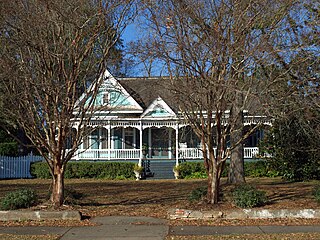
The Gaston-Perdue House is a historic residence in Greenville, Alabama. The house was built in 1895 by Butler County probate judge Zell Gaston. In 1903, following his term, Gaston moved to Birmingham and sold the house to physician J. L. Perdue.
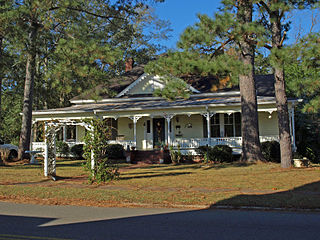
The Graydon House is a historic residence in Greenville, Alabama. The house was built in 1909, and typifies the southern Alabama vernacular house, with a hip roof and wrap-around porch. A gabled dormer is centered on the façade, and the porch has slender columns with elaborate brackets. Decorative woodwork continues inside, including Queen Anne fireplace mantels.

The Greenville Public School Complex is a historic school in Greenville, Alabama. Butler County High School was built in 1925 as a consolidated school serving the entire county. A second builing to house Walter O. Parmer Elementary School was completed on the same site in 1927. In 1937–38, the Public Works Administration constructed an auditorium, cafeteria, and manual arts training building. The high school was later renamed Greenville High School and has since relocated to a site along Interstate 65. A new building was constructed on site, and the campus is still used for Parmer Elementary.
























